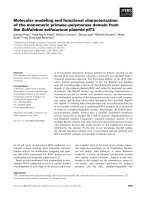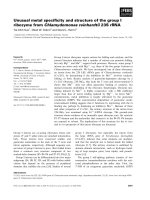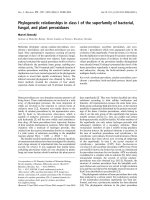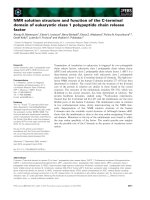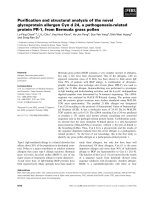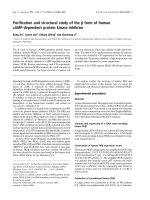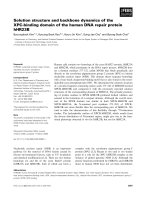Báo cáo khoa học: "Registration accuracy for MR images of the prostate using a subvolume based registration protocol" pps
Bạn đang xem bản rút gọn của tài liệu. Xem và tải ngay bản đầy đủ của tài liệu tại đây (856.37 KB, 5 trang )
RESEA R C H Open Access
Registration accuracy for MR images of the prostate
using a subvolume based registration protocol
Joakim H Jonsson
1*
, Patrik Brynolfsson
1
, Anders Garpebring
1
, Mikael Karlsson
1
, Karin Söderström
2
and
Tufve Nyholm
2
Abstract
Background: In recent years, there has been a considerable research effort concerning the integration of magnetic
resonance imaging (MRI) into the external radiotherapy workflow motivated by the superior soft tissue contrast as
compared to computed tomography. Image registration is a necessary step in many applications, e.g. in patient
positioning and therapy response assessment with repeated imaging. In this study, we investigate the dependence
between the registration accuracy and the size of the registration volume for a subvolume based rigid registration
protocol for MR images of the prostate.
Methods: Ten patients were imaged four times each over the course of radiotherapy treatment using a T2
weighted sequence. The images were registered to each oth er using a mean square distance metric and a step
gradient optimizer for registration volumes of different sizes. The precision of the registrations was evaluated using
the center of mass distance between the manually defined prostates in the registered images. The optimal size of
the registration volume was determined by minimizing the standard deviation of these distances.
Results: We found that prostate position was most uncertain in the anterior-posterior (AP) direction using
traditional full volume registration. The improvement in standard deviation of the mean center of mass distance
between the prostate volumes using a registration volume optimized to the prostate was 3.9 mm (p < 0.001) in
the AP direction. The optimum registration volume size was 0 mm margin added to the prostate gland as outlined
in the first image series.
Conclusions: Repeated MR imaging of the prostate for therapy set-up or therapy assessment will both require high
precision tissue registration. With a subvolume based registration the prostate registration uncertainty can be reduced
down to the order of 1 mm (1 SD) compared to several millimeters for registration based on the whole pelvis.
Keywords: MRI, image registration, prostate, radiotherapy, subvolume, localized, cancer
Introduction
The role of magnetic resonance imaging (MRI) in modern
prostate external radiotherapy treatments has in recent
years attracted a lot of scientific attentio n. The applica-
tions span from MRI ba sed treatment planning [1-4] to
assessment of treatment response using different MRI
techniques such as dynamic contrast enhanced MRI
(DCE-MRI) [5,6], diffusion weighted imaging (DWI) [7,8]
and magnetic resonance spectroscopy (MRS) [9]. It is
widely accepted in the radiotherapy community that MRI
is the preferred choice for target de lineation of e.g. pros-
tate, due to its superior soft tissue contrast [10]. It has also
been shown that multi-modal registration between MRI
and computed tomography (CT) increases the systematic
uncertainty of the treatment [11]. It is therefore desirable
to develop an MR only workflow where the treatment
planning, patient positioning and treatment response eva-
luation is based on MR imaging. The soft tissue contrast
and non-ionizing properties of the MRI s canner make it
ideal for daily patient positioning. Several solutions on
integration of MRI into the external radiotherapy proce-
dure for this purpose have been suggested in literature,
e.g. integrated MR scanner-accelerator solutions [12,13] or
* Correspondence:
1
Radiation Physics, Department of Radiation Sciences, Umeå University,
90187 Umeå, Sweden
Full list of author information is available at the end of the article
Jonsson et al. Radiation Oncology 2011, 6:73
/>© 2011 Jonsson et al; licensee BioMed Central Ltd. This is an Open Access article dis tributed u nder the terms of the Creative Commons
Attribution License ( which permits unrestricted use, distribution, and reproduction in
any medium, provided the original work is properly cited.
using a patient transport solution from a nearby MR scan-
ner [14].
Image registration is an essential part o f medical
image analysis. It can be used to combine multi-modal
images via image fusion [15,16], align four dimensional
images [17], correct for patient setup errors [18],
respiratory tracking [19], automatic image segmentation
[20], contour propagation [21] and many other pur-
poses. All of these applications are present in a mode rn
radiotherapy departme nt during treatment planning, the
treatment delivery as well as during patient follow-up
and tumor response evaluation.
In patients with clinically localized prostate cancer, tra-
ditional rigid registration between image volumes
acquired at different times may not perform adequately
with respect to the tumor shape and position, since the
prostate can move with respect to the bony anatomy and
external patient contour [22]. This makes ordinary rigid
registration, based on the entire patient anatomy, impre-
cise. In order to align the prostate volume with high pre-
cision, there is a need f or a registration of the prostate
only. One way of accomplishing this is the use of intra-
prostatic fiducial markers. The radi o opaque markers are
implanted into the prostate gland, and can thereafter be
visualized using most imaging modalities. By manually
defining the markers in the two image sets, the images
can be registered so that the markers are as close to each
other as possible. This implicitly registers the images
with focus on the prostate area, provided that the mar-
kers have not migrated within the prostate gland.
A non-invasive path to localized registration of mobile
organs is subvolume based rigid registration taking only
the volume of interest into account. For patient posi-
tioning, the subvolume based rigid registration approach
has the advantage that the registration results can be
readily i nterp reted as couch mo vements, making instant
adjustment of patient position possible. The properties
of subvolume based registration have been investigated
for repeat CT [23] and cone beam CT (CBCT) [24], but
to our knowledge not yet for MRI.
In the present study we investigate the precision o f
subvolume based rigid registration of the prostate for ten
patients with four repeat MR scans each. The aim was to
quantify the registration precision and its dependence of
the registration volume for a mean square metric based
algorithm, i.e. determine the optimal size of the registra-
tion volume to be used for alignment of MR images for
treatment respon se evaluation and external radiotherapy
purposes.
Methods
Patients
Ten patients with median age 58 years (range 52-69
years) scheduled for pre-treatment pelvic MRI scans
were included in the study. All patients were treated
with fractionated external radiotherapy using three dif-
ferentprotocols.Thechoiceofradiotherapyprotocol
did not influence the prostate delineation to be used in
the study.
Imaging
Prior to treatment the patients were imaged with an
Espree 1.5 T MR scanner (Siemens Medical, Erlangen,
Germany) using a T2 weighted high resolution 3D
sequence (SPACE) with axial slices (repetition time was
1500 ms, echo time was 209 ms, number of slice averages
was 1, slice thickness 1.7 mm, 120 slices, pixel bandwidth
590 Hz/pixel, flip angle 150 degrees, matrix size 384 ×
348, in-plane pixel size 1.17 × 1.17 mm). This MR
sequence is part of the normal clinical protocol and is
used for target defini tion. The same MR s equence was
repeated three times during the treatment duration, yield-
ing a total o f four MR image sets for each patient. The
patients were placed on a flattabletopinsertduringthe
MR imaging, and the images were acquired with the body
matrix and spine coil.
During the MR i maging, the patients were placed in
the scanner in supine position with the standard treat-
ment fixation devices, which consist of a knee cushion
that prevents rotation of the pelvis.
Delineation
The prostate gland registration volume, defined as RV
0
,
was delineated by a hospital physicist in collaboration
with a radio oncologist on the pre-treatment image sets.
RV
0
included the entire prostate gland excluding the
seminal vesicles. 3D margins of 1, 2 and 3 cm were added
to RV
0
to create different registration volumes denoted as
RV
1
,R2
V
and RV
3
, see Figure 1. A volume corresponding
to RV
0
was delineated on the treatment image sets. This
volume did not affect the registration in any way, but was
used solely for analysis purposes.
Registration
In order to register the images with respect to the soft
tissue in the target and not take the bony anatomy and
external patient contour into account, the metric calcula-
tion n eeds to be constructed in such a way that only
values within a specific region of interest, i.e. the registra-
tion volume, are taken into account. This was accom-
plished by use of binary volumes, i.e. masks, which define
in what region the metric values should b e calculated.
These masks were created by converting the contours
delineated by the authors to binary volumes.
We used MATLAB (MathWorks, Natick, MA) and the
Insight Toolkit (ITK) to develop a method for MR-MR
image registration. Since it was a single modality regis-
tration problem, we used a mean square metric. A step
Jonsson et al. Radiation Oncology 2011, 6:73
/>Page 2 of 5
gradient descent approach, the VersorTransformOptimi-
zer, was used for the optimization.
We registered the pre-treatment MRI to the ot her 3
image sets for each patient, using the complete volume,
RV
0
mask, RV
1
mask, RV
2
mask and RV
3
mask. This
yielded a total number of 150 MR-MR registrations.
Analysis
We quantified the registration uncertainty as the stan-
dard deviation of the center of mass distance between
theprostategland(RV
0
) binary masks for each pair of
registered images. This measure has a clinical relevance
as the center of mass distance vector corresponds to the
couch shift vector when positioning the patient. The
registration uncertainty was scored for each main direc-
tion x (right-left), y (anterior-posterior) and z (cranio-
caudal) and for the norm of this vector. We used F-tests
to test for significance in the d ifference of variance in
registrations between different pairs of registration
volumes.
Results
The registrations were performed for all patients and all
registration volumes for the MR series, see Figure 2.
The standard deviation of the center of mass distance
post registration was reduced with a decrease in regis-
tration volume. The reduction was most pronounce d in
the a nterior-posterior direction, from 5.2 mm with full
volume registration to 1.3 mm (p < 0.001) using RV
0
.In
the cranio-caudal direction the standard deviation was
reduced from 3.2 mm to 1.7 mm (p < 0.001), and in the
right-left direction the reduction of the standard devia-
tion was modest, from 0.7 mm to 0.5 mm (p = 0.08),
also using RV
0
. The standard deviation of the norm of
the vector was reduced from 2.8 mm to 0.8 mm (p <
0.001). The mean, median and range of the norm
improvement are presented in table 1, together with
p-values for difference in variance between the specific
registration volumes comp ared to the full volume regis-
trations. Negative numbers indicate that the subvolume
based registration failed to produce a better result than
the full volume registration. The numbers indicated in
the min row all occurred for the same patient image
set w here registration failed, see Figure 3. Exclusion of
this atypical image set would have led to a minimum
improvement around -1 mm.
Figure 2 shows that the registration uncertainty in the
anterior-posterior direction is more sensitive to the size of
the registration volume, compared to the cranio-caudal
and right-left directions. For the largest registration
volumes RV
2
and RV
3
, as well as full volume registration,
the anterior-posterior direction contributes to the largest
part of the total registration uncertainty. This is likely due
to the increase in rectal volume included in the registra-
tion volume.
The registration volume that gave the most precise
results was RV
0
for 77% of the image pairs, RV
1
and
RV
2
for 10% of the pairs each, and RV
3
was most
Figure 1 Registration volumes. The figure demonstrates an MR
image with the different registration volumes RV
0
(solid line), RV
1
,
RV
2
and RV
3
(dotted lines).
Figure 2 Registration results. Center of mass standard deviations
per coordinate, grouped by registration volume. The colored bar
represents the mean center of mass distance and the error bars
displays ± 1 standard deviation. The variance in center of mass
distance is stable for the right-left direction, but increases with
increasing registration volume size for the other directions.
Table 1 Registration results
RV
0
RV
1
RV
2
RV
3
Min -0.48 -4.39 -9.47 -3.26
Max 11.09 11.15 8.76 7.78
Median 2.34 1.63 1.32 1.19
Mean 3.13 2.40 1.58 1.56
p < 0.001 < 0.001 0.03 0.02
Mean, median and range of improvement (norm) from full volume registration
to subvolume based registration with different registration volumes. Negative
numbers indicate that the subvolume based registration failed to produce a
better result than the full volume registration.
Jonsson et al. Radiation Oncology 2011, 6:73
/>Page 3 of 5
precise only for 3% of the cases. These results are not
surprising, since the larger registration volumes include
more of the rectum and bladder. Hence, the registration
algorithm includes chan ges in these areas, leading to a
degradation of the registration with respect to the
prostate.
Discussion
The results in this study clearly demonstrate that subvo-
lume based rigid registration improves the registration
precision w ithin the area of interest. However, as with
all registration protocols, there is a need for quality con-
trol such as visual inspection to make sure t hat the
registration has not failed. The subvolume based pro to-
col has applications within patient positioning using
image guided radiotherapy and when using multiple
imaging for treatment response evaluation.
The MR-MR s ubvolume based registration proto col
described in t he present study performs optimally when
applied to a registration subvolume with no margin
added to the prostate gland. In a study by Mclaughlin et
al [25] regarding subvolume based registration between
MRandCT,theprostatevolumewithnomargindid
not result in a successful registration due to the lack of
information in the prostate area of the CT. In this
study, a 2 cm margin added to the prostate was required
to ensure a successful registration.
An alternative approach is non-rigid image registra-
tion for treatment adaptation. Chao et al [26] used
deformable registration to warp a narrow shell and
map contours from a planning CT to CBCT images.
Wang et al [27] used deformable registration over the
entire volume to map contours from a planning CT to
25repeatCTsforaprostatepatient.Aproblemwith
deformable registration for image guided radiotherapy
is that it requires online replanning or some other
form of plan modification. There is n o obvious way to
interpret the deformation field into a table movement
that can be applied immediately. Instead, the multi leaf
collimator must be adapted to the new contour, and
the dose distribution should be recalculated. This pro-
blem does not occur when using localized rigid regis-
tration since the registration transform can be readily
interpreted as couch movement to reposition the
patient. While online plan modification may increase
the accuracy of the delivered dose, it is currently t ime
consuming and not easily implemented in a cli nical
setting.
The implantation of f iducial gold markers into the
prostate for localize d rigid registration, while accurate if
applied properly, has disadvantages compared to the
proposed method of registration; it is invasive and the
position of the gold markers in the MR images does not
necessarily correspond to the markers actual position,
depending on sequence parameters [28]. The proposed
method is automatic with no need for user interaction
and does not require any additional steps in the work-
flow. In an ex ternal radiotherapy workflow, the registra-
tion volume can simply be set to the prostate volume
defined by the radio oncologist during target definition.
The resulting uncertainties from this study indicate
that a standard deviation of approximately 1 mm can be
achieved in an automatic procedure. Data from the CT-
based study [23] indicate similar results, based on more
registrations but with outlier removal, which was not
performed in the current study.
Conclusions
The subvolume based rigid registration of MR scans of
the prostate improves the precision significantly as com-
pared to full v olume registration. Our results indicate
that the optimal registration volume is the prostate itself
without a ny additional surrounding tissue. The subvo-
lume based registration procedure can be applied in an
image guided ra diotherapy protocol and can be used for
registration of repeated MR-imaging of the prostate.
Author details
1
Radiation Physics, Department of Radiation Sciences, Umeå University,
90187 Umeå, Sweden.
2
Oncology, Department of Radiation Sciences, Umeå
University, 90187 Umeå, Sweden.
Authors’ contributions
JJ gathered the data, delineated the contours in collaboration with KS,
created software needed for the study and drafted the manuscript. PB and
AG aided in the creation of the registration software. MK participated in the
design and coordination of the study. TN conceived the study and helped
draft the manuscript. All authors read and approved the final manuscript.
Competing interests
The authors declare that they have no competing interests.
Received: 21 March 2011 Accepted: 16 June 2011
Published: 16 June 2011
Figure 3 Failed registration. The failed registration reflected in the
min row in table 1. The fixed image is displayed in grayscale and
the moving image is displayed using a green overlay. The full
volume registration can be seen to the left and the subvolume
based registration using RV
2
to the right. The misregistration is
obvious and is easily detected by visual inspection.
Jonsson et al. Radiation Oncology 2011, 6:73
/>Page 4 of 5
References
1. Chen L, Price RA Jr, Nguyen TB, Wang L, Li JS, Qin L, Ding M, Palacio E,
Ma CM, Pollack A: Dosimetric evaluation of MRI-based treatment
planning for prostate cancer. Phys Med Biol 2004, 49:5157-5170.
2. Chen L, Price RA Jr, Wang L, Li J, Qin L, McNeeley S, Ma CM, Freedman GM,
Pollack A: MRI-based treatment planning for radiotherapy: dosimetric
verification for prostate IMRT. Int J Radiat Oncol Biol Phys 2004, 60:636-647.
3. Jonsson JH, Karlsson MG, Karlsson M, Nyholm T: Treatment planning using
MRI data: an analysis of the dose calculation accuracy for different
treatment regions. Radiat Oncol 5:62.
4. Lee YK, Bollet M, Charles-Edwards G, Flower MA, Leach MO, McNair H,
Moore E, Rowbottom C, Webb S: Radiotherapy treatment planning of
prostate cancer using magnetic resonance imaging alone. Radiother
Oncol 2003, 66:203-216.
5. Franiel T, Ludemann L, Taupitz M, Bohmer D, Beyersdorff D: MRI before
and after external beam intensity-modulated radiotherapy of patients
with prostate cancer: the feasibility of monitoring of radiation-induced
tissue changes using a dynamic contrast-enhanced inversion-prepared
dual-contrast gradient echo sequence. Radiother Oncol 2009, 93:241-245.
6. Lee KC, Sud S, Meyer CR, Moffat BA, Chenevert TL, Rehemtulla A, Pienta KJ,
Ross BD: An imaging biomarker of early treatment response in prostate
cancer that has metastasized to the bone. Cancer Res 2007, 67:3524-3528.
7. Jennings D, Hatton BN, Guo J, Galons JP, Trouard TP, Raghunand N,
Marshall J, Gillies RJ: Early response of prostate carcinoma xenografts to
docetaxel chemotherapy monitored with diffusion MRI. Neoplasia 2002,
4:255-262.
8. Song I, Kim CK, Park BK, Park W: Assessment of response to radiotherapy
for prostate cancer: value of diffusion-weighted MRI at 3 T. AJR Am J
Roentgenol 194:W477-482.
9. Carroll PR, Coakley FV, Kurhanewicz J: Magnetic resonance imaging and
spectroscopy of prostate cancer. Rev Urol 2006, 8(Suppl 1):S4-S10.
10. Khoo VS, Padhani AR, Tanner SF, Finnigan DJ, Leach MO, Dearnaley DP:
Comparison of MRI with CT for the radiotherapy planning of prostate
cancer: a feasibility study. Br J Radiol 1999, 72:590-597.
11. Nyholm T, Nyberg M, Karlsson MG, Karlsson M: Systematisation of spatial
uncertainties for comparison between a MR and a CT-based
radiotherapy workflow for prostate treatments. Radiat Oncol 2009, 4:54.
12. Kron T, Eyles D, John SL, Battista J: Magnetic resonance imaging for
adaptive cobalt tomotherapy: A proposal. J Med Phys 2006, 31:242-254.
13. Raaymakers BW, Lagendijk JJ, Overweg J, Kok JG, Raaijmakers AJ,
Kerkhof EM, van der Put RW, Meijsing I, Crijns SP, Benedosso F, et al:
Integrating a 1.5 T MRI scanner with a 6 MV accelerator: proof of
concept. Phys Med Biol 2009, 54:N229-237.
14. Karlsson M, Karlsson MG, Nyholm T, Amies C, Zackrisson B: Dedicated
magnetic resonance imaging in the radiotherapy clinic. Int J Radiat Oncol
Biol Phys 2009, 74:644-651.
15. Maes F, Collignon A, Vandermeulen D, Marchal G, Suetens P: Multimodality
image registration by maximization of mutual information. IEEE Trans
Med Imaging 1997, 16:187-198.
16. Pluim JP, Maintz JB, Viergever MA: Mutual-information-based registration
of medical images: a survey. IEEE Trans Med Imaging 2003, 22:986-1004.
17. Makela T, Clarysse P, Sipila O, Pauna N, Pham QC, Katila T, Magnin IE: A
review of cardiac image registration methods. IEEE Trans Med Imaging
2002, 21:1011-1021.
18. van Herk M: Different styles of image-guided radiotherapy. Semin Radiat
Oncol 2007, 17:258-267.
19. Coselmon MM, Balter JM, McShan DL, Kessler ML: Mutual information
based CT registration of the lung at exhale and inhale breathing states
using thin-plate splines. Med Phys 2004, 31:2942-2948.
20. Ellingsen LM, Chintalapani G, Taylor RH, Prince JL: Robust deformable
image registration using prior shape information for atlas to patient
registration. Comput Med Imaging Graph 34:79-90.
21. van der Put RW, Kerkhof EM, Raaymakers BW, Jurgenliemk-Schulz IM,
Lagendijk JJ: Contour propagation in MRI-guided radiotherapy treatment
of cervical cancer: the accuracy of rigid, non-rigid and semi-automatic
registrations. Phys Med Biol 2009, 54:7135-7150.
22. Balter JM, Sandler HM, Lam K, Bree RL, Lichter AS, ten Haken RK:
Measurement of prostate movement over the course of routine
radiotherapy using implanted markers. Int J Radiat Oncol Biol Phys 1995,
31:113-118.
23. Smitsmans MH, Wolthaus JW, Artignan X, de Bois J, Jaffray DA, Lebesque JV,
van Herk M: Automatic localization of the prostate for on-line or off-line
image-guided radiotherapy. Int J Radiat Oncol Biol Phys 2004, 60:623-635.
24. Smitsmans MH, de Bois J, Sonke JJ, Betgen A, Zijp LJ, Jaffray DA,
Lebesque JV, van Herk M: Automatic prostate localization on cone-beam
CT scans for high precision image-guided radiotherapy. Int J Radiat Oncol
Biol Phys 2005, 63:975-984.
25. McLaughlin PW, Narayana V, Kessler M, McShan D, Troyer S, Marsh L,
Hixson G, Roberson PL: The use of mutual information in registration of
CT and MRI datasets post permanent implant. Brachytherapy 2004,
3:61-70.
26. Chao M, Xie Y, Xing L: Auto-propagation of contours for adaptive
prostate radiation therapy. Phys Med Biol 2008, 53:4533-4542.
27. Wang H, Garden AS, Zhang L, Wei X, Ahamad A, Kuban DA, Komaki R,
O’Daniel J, Zhang Y, Mohan R, Dong L: Performance evaluation of
automatic anatomy segmentation algorithm on repeat or four-
dimensional computed tomography images using deformable image
registration method.
Int J Radiat Oncol Biol Phys 2008, 72:210-219.
28. Jonsson JH, Garpebring A, Karlsson MG, Nyholm T: Internal Fiducial
Markers and Susceptibility Effects in MRI-Simulation and Measurement
of Spatial Accuracy. Int J Radiat Oncol Biol Phys 2011.
doi:10.1186/1748-717X-6-73
Cite this article as: Jonsson et al.: Registration accuracy for MR images of
the prostate using a subvolume based registration protocol. Radiation
Oncology 2011 6:73.
Submit your next manuscript to BioMed Central
and take full advantage of:
• Convenient online submission
• Thorough peer review
• No space constraints or color figure charges
• Immediate publication on acceptance
• Inclusion in PubMed, CAS, Scopus and Google Scholar
• Research which is freely available for redistribution
Submit your manuscript at
www.biomedcentral.com/submit
Jonsson et al. Radiation Oncology 2011, 6:73
/>Page 5 of 5

